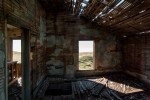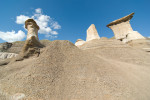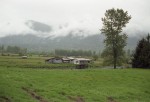Aug
17
2015
Photography can be about a lot of things and when it comes to carrying gear it can be about compromises. How much space do I have for lenses and how much weight am I willing to carry? When it comes to the wide angle end of things you can’t really beat having a really nice lens that captures an expansive view. Often though for reasons of weight it can be easier to just carry a lighter kit lens that maybe goes down to 18mm on APS-c or maybe a better lens that goes to 16mm but if your willing to carry the extra weight of an additional lens there is something special about going all the way to 12mm on APS-c. This would be equivalent to 18mm on a ‘full frame’ camera. The horizontal angle of view of a 12mm lens on APS-c equates to 88.5 degrees while an 18mm lens is 66 degrees this is a signifigant difference illustrated bellow. (Note I am referring to horizontal angle not diagonal, human vision with two eyes is nearly 180 degrees horizontally but a good portion of that is peripheral)

Done well a wide angle image helps to make the viewer feel more like they are right there looking at the scene for themselves. You can back up of course to take in more of the scene but that isn’t always an option as in the illustration image taken from a logging road bridge deck. Another option is to stitch together several images but that can have issues and isn’t suited to anything with motion. So sometimes there really is no substitute for a good wide-angle lens. Personally as I shoot with a Pentax APS-c DSLR I use the smc PENTAX-DA 12-24mmF4ED AL[IF] but there are different options for it and other camera systems. Additionally these images are combed from 4 different cameras (Pentax K10D,K7,K-01,K3) proving my assertion that spending money on a lens is a better long term investment than on a camera.

Here are sample images with this lens all taken at the widest setting of 12mm
2 comments | tags: lens, Pentax | posted in Cameras, Photography
Jan
18
2015

It’s been one year that I’ve had the HD PENTAX-DA 55-300mm F4-5.8 ED WR and I am still very pleased with it. For the money it is a very good lens and the weather sealing has been a definite plus for me.
It’s minor weak points seem to be an increase in softness and chromatic aberration as you move away from the image center towards the corners and it’s slower aperture at the long end (f5.8) but all things considered it does the job and provides photographic freedom for creating images. The distortions seen in the corners are at their strongest at 300mm and require stopping down to about f8.0 to make an appreciable difference. So after a year of use I would say unless I need f2.8 or some improvement in image quality I tend to take the lighter DA55-300 with me over the DA*50-135 because of its greater versatility and lighter weight. You can see my user review for it here HD PENTAX-DA 55-300mm F4-5.8 ED WR user review and some other thoughts here HD PENTAX-DA 55-300mm F4-5.8 ED WR and the rest of the kids. If I needed to I would buy it all over again.
Bellow are 100% views of some test images I shot. I created and printed a chart specifically to test the performance of the lens.

While I didn’t set the test up with extreme rigor it demonstrates my points and matches my findings in real world situations. The first image bellow is from the center of the HD DA55-300 ED WR at 120mm. You can see that when used at its widest aperture for this focal length the image is somewhat soft and with chromatic aberration showing up as purple fringing. Stopping the lens down to f9.0 decreases this type of aberation leaving primarily transverse aberations as seen by the red fringe on the now sharper image.

It should be noted that with some minor processing the chromatic aberations can be greatly reduced and further adjustments can yeild a superior image as seen in this before and after. Again taken from the center of the frame, now at 300mm but still with a wide open aperture of f5.8

As I mentioned previously the image corners suffer the most when it comes to distortions. The image that follows is taken from the upper left corner with an aperture change from f5.8 to f10 and no further processing.

Here for comparison purposes is a central crop from the DA*50-135 and the DA55-300 both at f9.0 (The camera was moved to provide similar framing) You can see that the DA* 50-135 is sharper and less distorted.

But with a little processing on images from both lenses the playing field is leveled slightly between them.

The image above is from the center of the frame where the image bellow is from the lower left which in the case of my lens seems to be the worst of the corners.

All this should be taken with a little bit of a grain of salt however as these are 100% crops from the demanding 24mpixel Pentax K-3 under more extreme conditions than the average picture is taken.

(The salt picture is taken with the DFA100 WR macro as the HD Pentax-DA 55-300mm F4-5.8 ED WR does not lend itself to this type of image making because of its maximum magnification of 0.28X)
It’s certainly not my intent to leave the reader with a lingering sense that the lens is weak. It’s actually a good lens optically and you are going to have to pay for any improvements either in limiting yourself to fixed focal lengths or by paying more money or both.
Here are some more images from the past year taken with this lens and the Pentax K-3 with a few cameos from the K-01 mirrorless.
2 comments | tags: DA 55-300, DA55-300, HD Pentax, HD Pentax-DA, lens, Pentax, Water resistant, WR | posted in Cameras, Photography
Sep
5
2014


The Pentax smc PENTAX-DA 40mm F2.8 XS Lens is an impossibly thin pancake lens that was originally designed to go with the digital APS-c Pentax K-01 but as some people have noted it also covers a full 35mm film frame. I needed to find out for myself so I mounted it to my Pentax MZ-6 a camera that I had given away but received back and am very happy about that. I had really under rated the camera, while not built to take a beating like a professional camera, it has all the functionality of one. Back to the lens though. While the lens is very thin it shouldn’t be all that surprising as many 35mm film point and shoot cameras have similar sized lenses that are often even closer to the film plane. As a lens used with 35mm film I can say that it does an excellent job with very little vignetting which is the one thing you might expect to see when using an APS-c lens. The fact that it takes up next to no room in a camera bag and that it can be used on both film and digital really makes this a must carry lens for me.
2 comments | tags: film, lens, Pentax | posted in Cameras, Photography, Uncategorized
Jul
21
2014

Duncan Turner of DLT photographic had the brilliant idea to repurpose his child bicycle trailer into a camera gear trailer (No actual conversion is required). The only downside is the looks people give, some people clearly want to get a peak at what must be a cute baby and still others look on disapprovingly as you carelessly subject your little one to dangerous maneuvers. All the while though the cameras are snug as little bugs shielded from the rain and mud. While the bulk of my gear was being towed about I had my Pentax K-3 slung over my shoulder with the HD PENTAX-DA 55-300mm F4-5.8 ED WR mounted on it.

There was a lot of rain that didn’t let up very much, which dampened my photographic spirits, but had no effect on the camera or lens. Here is a sampling from that gear combination. It’s not the fastest lens nor does it have the least distortion but it does give me some focal length reach which I appreciate.
no comments | tags: lens, Pentax | posted in Cameras, Photography
Mar
29
2014

This post serves a dual purpose: one as an ode to spring 2014 and the other as a test of the Pentax M Macro 1:4 100mm lens on my Pentax K-01. I am happy with the performance of this lens even when used at its widest aperture. It only remains to be tested with 35mm film but I suspect it will do just as well with the added benefit of allowing me to share the lens between film and digital. It’s slightly more compact than the DFA 100 Macro WR and is manual focus but it actually seems better suited to the K-01 and the way that this mirrorless camera is used. In fact with its focus peeking the K-01 is an ideal manual focus camera.
1 comment | tags: Digital, lens, Pentax | posted in Cameras, Photography
Aug
12
2013
The oops comes from the fact that I tried the Pentax DFA100 macro WR lens with the Pentax Super Program, these pictures are not from that lens. 
The smc PENTAX D FA 100mm F2.8 WR Macro doesn’t have an aperture ring but relies on the camera body to adjust the aperture. That is not a problem when using it with a DSLR or even a more modern film camera. The Super Program though is not one of these it indicates a particular aperture in the viewfinder but that doesn’t correspond with the lens setting. This fact makes this type of lens/camera combination incompatible. The images I took are terribly due to underexposure, it seems that the lens was completely stopped down as far as possible f32. It does work very well with my Pentax PZ1p though.
2 comments | tags: film, lens, Pentax | posted in Cameras, Photography, Uncategorized
May
18
2013

Most of the images were taken with the Vivitar 28mm 1:2.0 Close Focus lens. The extra stop of light you get with this lens compaired to using a Pentax 28mm 1:2.8 might be useful in low light but it’s the ability to focus down to 23cm (roughly 9 inches) is what is the best thing about it. It is a heavy piece of glass and metal though and outways the Pentax 28mm to the point where its almost too heavy on my Pentax K-01. Otherwise if you can spare the weight it will deliver unique results.
no comments | tags: camera, lens, Pentax | posted in Cameras, Photography
Dec
21
2012

Note the letter Q is silent. If you’ve stumbled across this information erroneously in an effort to find something meaningful on the Internet my apologies. So what is this oddity? I’m pleased you asked, no one else ever does. I’ve taken the lens from an APS film Konica Revio CL which has a 25mm focal length and a speed of 1:6.7 and adapted it to the Pentax Q mount. In order to do this I’ve duplicated the distance from the back of the lens to the film only now it’s to the sensor. During the disassembly I preserved the helical focus mechanism. I now turn it by hand using a small stud threaded into the decorative front of the lens. The lens itself is no great performer it’s 3 elements in three groups and doesn’t appear to have any coatings. I’ve found that despite my best efforts at focus most of my mid to far distance shots are on the soft side. This could partially be attributed to defraction caused by the 6.7 f-stop. Where this lens does perform well is at close distances and as a macro lens. The 25mm focal length on the Q yields a “35mm full frame” equivalent of 138mm, that coupled with the fact that the over-ridden focus allows you to get within inches of the subject, you have a large degree of magnification. 
Back to the Q being silent, not only is the Letter Q silent in the name of this lens the camera itself is completely silent as it now uses its electronic shutter. A note on focus. In order to focus reasonably well I’ve turned on focus peaking which was added to the Q with firmware upgrade 1.10, additionally I’ve set 4 times magnification on when manually focusing. The magnification is enacted by pressing OK on the rear control dial. To provide an idea of how small an object you can photograph with this lens here is a lilliputian mushroom in front of a pad lock key. 
For me I see using the Pentax Q as an opportunity to expand the boundaries of what I’m able to photograph, this is the reason I recently purchased the Pentax fisheye lens and am building lenses that do something I can’t do with any of my other gear. Next on my build list are a wide-angle and a telephoto.
3 comments | tags: Konica, lens, Pentax | posted in Cameras
Nov
12
2012

While not quite pocketable the combination of the Pentax Super Program and the M40 Pancake lens does make a relatively small package. I used some off brand film that was outdated by 6 years but it seems to be fine for this use and I made some extreme adjustments to the digital files anyway.
Other cameras in this small SLR class would be the Nikon FG and the Olympus OM-1 both alternatives having better direct exposure controls.
5 comments | tags: film, lens, Pentax | posted in Cameras, Photography, Processing
Oct
10
2012
Placing distortion inducing optical elements in front of expensive cameras is all the rage these days and all the hipsters are doing it so I didn’t want to miss out. There is a line of products called Lensbaby that allows for selective focus by essentially tilting the front element. My setup is a little different I’ve taken a wide angle adapter intended for video and mounted it on the front of the lens. This isn’t so much selective focus as the worlds worst astigmatism. The camera I’ve victimized is an interesting one. It’s actually a point and shoot SLR with a prism finder and a fixed 41mm 1:2.8 lens. Take a moment to think about that as I wind the next frame with the thumb wheel. Yes SLR, Yes thumb-wheel, fixed lens, No the mirror actually performs as the shutter, so many questions. The mirror/shutter has a single speed and you select the aperature via a ring around the base of the lens. To use the meter you press the little green button on the top plate near the shutter button. Three LED’s let you know if you are under, over exposed or just right(ish).

Back to the wide angle adapter it has a magnification of .55 which multiplied against the lenses 41mm yields 22.5mm of wide-angle badness. Of course I didn’t use it for all the shots see if you can tell which ones.
no comments | tags: camera, film, lens | posted in Cameras, Photography

































































































































































































































